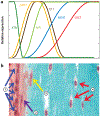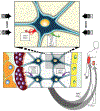The Osteocyte: New Insights
- PMID: 32040934
- PMCID: PMC8274561
- DOI: 10.1146/annurev-physiol-021119-034332
The Osteocyte: New Insights
Abstract
Osteocytes are an ancient cell, appearing in fossilized skeletal remains of early fish and dinosaurs. Despite its relative high abundance, even in the context of nonskeletal cells, the osteocyte is perhaps among the least studied cells in all of vertebrate biology. Osteocytes are cells embedded in bone, able to modify their surrounding extracellular matrix via specialized molecular remodeling mechanisms that are independent of the bone forming osteoblasts and bone-resorbing osteoclasts. Osteocytes communicate with osteoclasts and osteoblasts via distinct signaling molecules that include the RankL/OPG axis and the Sost/Dkk1/Wnt axis, among others. Osteocytes also extend their influence beyond the local bone environment by functioning as an endocrine cell that controls phosphate reabsorption in the kidney, insulin secretion in the pancreas, and skeletal muscle function. These cells are also finely tuned sensors of mechanical stimulation to coordinate with effector cells to adjust bone mass, size, and shape to conform to mechanical demands.
Keywords: FGF23; RANKL; mechanosensation; osteocytes; perilacunar remodeling; sclerostin.
Figures





References
-
- Smith MM, Hall BK. 1990. Development and evolutionary origins of vertebrate skeletogenic and odontogenic tissues. Biol. Rev. Camb. Philos. Soc 65:277–373 - PubMed
-
- Pawlicki R 1975. Studies of the fossil dinosaur bone in the scanning electron microscope. Z. Mikrosk. Anat. Forsch 89:393–98 - PubMed
-
- Schweitzer MH, Zheng W, Cleland TP, Bern M. 2013. Molecular analyses of dinosaur osteocytes support the presence of endogenous molecules. Bone 52:414–23 - PubMed
-
- von Recklinghausen F 1910. Untersuchungen über Rachitis und Osteomalacia. Jena, Ger.: Gustav Fischer
-
- Bélanger LF. 1969. Osteocytic osteolysis. Calcif. Tissue Res 4:1–12 - PubMed
Publication types
MeSH terms
Grants and funding
LinkOut - more resources
Full Text Sources

